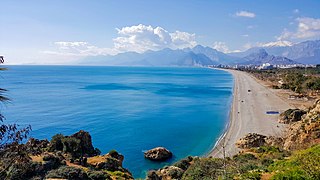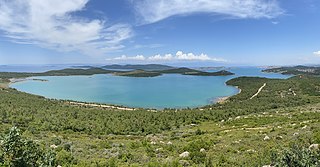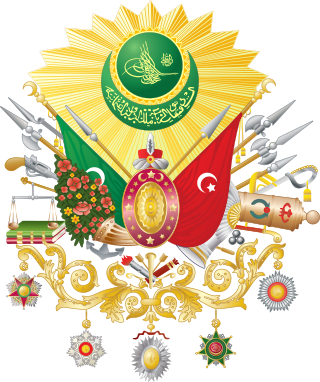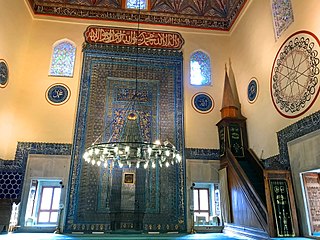
Ankara, historically known as Ancyra and Angora, is the capital of Turkey. Located in the central part of Anatolia, the city has a population of 5.1 million in its urban center and 5.8 million in Ankara Province, making it Turkey's second-largest city after Istanbul, but first by the urban area (4,130 km2).

Nicosia, also known by its Greek name Lefkosia, its Turkish name Lefkoşa, and by several other names, is the capital and largest city of Cyprus.

Trabzon, historically known as Trebizond, is a city on the Black Sea coast of northeastern Turkey and the capital of Trabzon Province. Trabzon, located on the historical Silk Road, became a melting pot of religions, languages and culture for centuries and a trade gateway to Persia in the southeast and the Caucasus to the northeast. The Venetian and Genoese merchants paid visits to Trabzon during the medieval period and sold silk, linen and woolen fabric. Both republics had merchant colonies within the city – Leonkastron and the former "Venetian castle" – that played a role to Trabzon similar to the one Galata played to Constantinople. Trabzon formed the basis of several states in its long history and was the capital city of the Empire of Trebizond between 1204 and 1461. During the early modern period, Trabzon, because of the importance of its port, again became a focal point of trade to Persia and the Caucasus.

Adana is a large city in southern Turkey. It is situated on the Seyhan River, 35 km (22 mi) inland from the Mediterranean Sea. The administrative seat of Adana province, which had a population of 2.274 million according to the official end-2022 estimates, the city itself had a population of 2,274,000 at that date, making it the fifth most populous city in Turkey.

Üsküdar is a municipality and district of Istanbul Province, Turkey. Its area is 35 km2, and its population is 524,452 (2022). It is a large and densely populated district on the Anatolian (Asian) shore of the Bosphorus. It is bordered to the north by Beykoz, to the east by Ümraniye, to the southeast by Ataşehir and to the south by Kadıköy; with Karaköy, Kabataş, Beşiktaş, and the historic city center of Fatih facing it on the opposite shore to the west. Üsküdar has been a conservative cultural center of the Anatolian side of Istanbul since Ottoman times with its numerous historic landmark and little mosques and dergahs.

Antalya is the fifth-most populous city in Turkey and the capital of Antalya Province. Recognized as the "capital of tourism" in Turkey and a pivotal part of the Turkish Riviera, Antalya sits on Anatolia's southwest coast, flanked by the Taurus Mountains. With over 2.6 million people in its metropolitan area, it is the largest city in Turkey's Mediterranean Region, situated along the Mediterranean Sea.

Fatih is a municipality and district of Istanbul Province, Turkey. Its area is 15 km2, and its population is 368,227 (2022). It is home to almost all of the provincial authorities but not the courthouse. It encompasses the historical peninsula, coinciding with old Constantinople. In 2009, the district of Eminönü, which had been a separate municipality located at the tip of the peninsula, was once again remerged into Fatih because of its small population. Fatih is bordered by the Golden Horn to the north and the Sea of Marmara to the south, while the Western border is demarked by the Theodosian wall and the east by the Bosphorus Strait.
This page is a list of places of interest in Bursa Province, Turkey.

Ayvalık Islands, are the group of islands around Ayvalık district of Turkey in Balıkesir Province in the Northeastern Aegean Sea. There are 22 islands and numerous rocks in the group, with Cunda Island, now a peninsula, being the largest. People live only on Cunda and Lale Islands. Cunda and Lale islands are linked to Ayvalık on the mainland, by a causeway enabling transportation by car. Cunda also has a ferry link from the main town, Alibey, to Ayvalık during the summer.
The Susurluk scandal was a 1996 political scandal in Turkey that exposed a close relationship between the Turkish government, the ultra-nationalistic paramilitary Grey Wolves organization and the Turkish mafia. It took place during the peak of the Kurdish–Turkish conflict in the mid-1990s.

The following outline is provided as an overview of and topical guide to the Ottoman Empire:
An exonym is a place name, used by non-natives of that place, that differs from the official or native name for that place. Turkish has a wealth of exonyms in areas beyond the current borders of Turkey notably those that were once part of Ottoman Empire and its vassals and tributaries or within the Turkish, Ottoman, or a Turkic sphere of cultural or economic influence. In addition, Turkish sometimes renders the names of other cities in phonetic Turkish spelling, e.g., Chicago as Şikago or Manchester as Mançester. As these forms are not commonly used in Turkish, there is no systematic attempt to include them here.

Eşek Island, also known as Kara Island, Goni Adasi or Donkey Island, is an island to the north of Çeşme in İzmir Province of Turkey. Located on the east side of the Chios Strait opposite the Greek island of Chios, it is the largest of a group of uninhabited islands sitting at the mouth of the Ildır bay which is situated between the Çeşme and Karaburun peninsulas.
The toponyms of Turkey result from the legacy left by several linguistic heritages: the Turkish language, the Greek language, the Armenian language, the Kurdish language, the Laz language as well as several other languages once spoken widely in Turkey. Turkey's place names range from those of unknown or unrecognizable origins to more clearly derivable onomastics. Many places have had their names changed throughout history as new language groups dominated the landbridge that present day Turkey is. A systematic turkification of place names was carried out when the worldwide wave of nationalism reached Turkey during the 20th century.
Kuruluş: Osman is a historical fiction Turkish television series produced by Bozdağ Film. The first episode of the series, directed by Metin Günay and written by Mehmet Bozdağ, was aired on November 20, 2019. The show is a continuation of the TRT 1 series Diriliş: Ertuğrul, which was broadcast between 2014 and 2019.

Early Ottoman architecture corresponds to the period of Ottoman architecture roughly up to the 15th century. This article covers the history of Ottoman architecture up to the end of Bayezid II's reign, prior to the advent of what is generally considered "classical" Ottoman architecture in the 16th century. Early Ottoman architecture was a continuation of earlier Seljuk and Beylik architecture while also incorporating local Byzantine influences. The new styles took shape in the capital cities of Bursa and Edirne as well as in other important early Ottoman cities such as Iznik. Three main types of structures predominated in this early period: single-domed mosques, "T-plan" buildings, and multi-domed buildings. Religious buildings were often part of larger charitable complexes (külliyes) that included other structures such as madrasas, hammams, tombs, and commercial establishments.